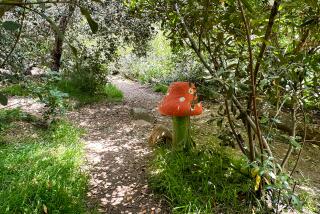Essentials for the tool shed

GARDENING books are great at telling us what to do. Occasionally they tell us how. Rarely do they descend to specific information on the subject of tools: which, where, why, when. Gardeners could cripple themselves carrying sacks of manure and compost from driveway to garden before discovering a wheelbarrow, by which time they would be past caring whether to rototill or use a pick and garden fork. So, in the course of considering my own recommendations, I went to a selection of California gardeners to ask what their favorite tools are, when they use them, for what and why. Among the 10 of us, a fascinating pattern of preferences emerged, along with enough gimmicky brand names (surely E-Z-Chore is an oxymoron?) to drive an English teacher to violence. For every tool there was a purpose. The most repeated observation: If it hurts to do a job in the garden, you are probably using the wrong tool.
*
Pruning
Pruners: Also called secateurs. Eight votes. If a professional gardener’s pruners are Felcos, it is because the tools made by the Swiss-based manufacturer have replaceable parts, come in different sizes and weights, and are designed for repeated use. Most but not all pruners are called “bypass,” meaning that the blades cross each other like scissors, an arrangement thought best for a clean cut of living stems rather than deadwood. Other distinctions concern what is best for the hand holding the pruners. Felco labels its pruners by number, No. 2 being the original tool, equipped with shock absorbers and designed for large hands. No. 8 is an ergonomic update, No. 6 a light, petite model for small hands, No. 9 for lefties.
Brian Helgoe, garden maintenance advisor for Valley Crest Tree Co. in Calabasas, prefers the No. 8 (above, far left on shelf) because the narrow anvil allows a cleaner angle when making a cut in the crotch of a branch. No. 11 (third from right), another version of the 2, has the narrow anvil of the 8 and shock absorbers, and it can prune 1-inch branches. Renee Gunter, garden designer of Urbanscapes in Los Angeles, likes the No. 13 for the long handle, firm grip and long blade that allow her to cut branches up to 1 1/2 inches in diameter. The 2, 8 and 11 cost $35.39 at the Felco Store, https://www.felcostore.com , or $44 at Smith & Hawken. Three experts like their Coronas, which cost $13.83 at Orchard’s Edge, https://www.orchardsedge.com . Fiskars bypass pruners start at $19.97 at Home Depot.
Shears and loppers: There are those who cut and those who saw. At the Huntington Library, Art Collections and Botanical Gardens, head gardener of perennials Katarina Eriksson cuts. She equips her team with orchard loppers (second from left) and pruning shears (two on far right). The keys to quality in both tools, she says, are weight and sharpness. The Oregon-based company Barnel produces light loppers with good torque and sharp blades. For pruning, she recommends its small head 20-inch lopper B20A; for hedging, the yellow-handled 27 1/2 -inch B1000L. “My gardeners and I fight over this one,” she says. The B1000L hedgers are sold locally for $41.45 by the Bishop Co., 12519 E. Putnam St., Whittier; (800) 421-4833.
Pruning saw: “A good folding handsaw is almost my favorite tool,” Helgoe says. “If a cut’s too big for secateurs, you should be using a handsaw. With a saw, you can cut a half inch- up to a 4-inch branch without any real fatigue and make good clean cuts.” Village Blacksmith folding pruning saw $14.96 at Home Depot, compact handsaw $14.50 from Lee Valley Tools at https://www.leevalley.com , Corona Clipper $24.99 at Ace Hardware, 600 folding saw $21.89 from Felco.
Bonsai scissors (top with loop handles): “Good for clipping delicate stems of flowers and herbs,” says Eriksson. Available from San Gabriel Nursery & Florist, (626) 286-3782 or https://www.sgnursery.com , 1 1/2 - to 2-inch carbon steel blades from $17.99 to $27.99 or 2-inch stainless steel blades $44.99. Corona Floral Snip scissors $12.50 from Orchard’s Edge, https://www.orchardsedge.com .
*
RakingRakes: Nothing declares a job well done like freshly raked mulch or gravel. Howard Formby, head of the maintenance division of Nancy Goslee Power & Associates, recommends two standard flex rakes: a medium-size one for leaves and a small one to get between hedges. The merrier the color, the better. The red one featured here costs $14.05 from Ewing Irrigation, 2327 Federal Ave., Los Angeles; (310) 479-9533. Lowe’s has a True Temper 24-inch leaf rake in green (above, middle) for $16.97. Decidedly quaint bamboo hedge rakes (including the one pictured at the bottom) are $2.99 from Green Arrow Nursery, 8845 Sepulveda Blvd., North Hills; (818) 894-8301.
*
ProtectionGloves: Gloves are to gardening what condoms are to sex. Sometimes we need them, for instance when reaching behind a shrub to check a soaker hose, when you might encounter a black widow, or when pruning roses or citrus suckers.
Find good-fitting leather gloves (E-Z-Chore from $5.99), or for roses, elbow-length gloves ($19.99) from Green Arrow Nursery in North Hills. For weeding, Huntington gardener Eriksson recommends Atlas 370 Nitrile Touch and the Atlas 310 Garden Grip for their unobtrusiveness; go to palmflex.com/atlas.htm.
“They hold up very well,” she says, “and I can feel the plants and weeds. Easy to wash.”
*
General
Hand garden fork: Formby has no use for a trowel but wouldn’t be without its companion hand fork. “It helps noodle out a weed without disturbing the roots of a nearby plant,” he says. See Campbell Tool Co.’s four-prong Superfork, three-pronged Eurofork and the two-pronged Superfork 2. https://www.campbelltool.co.nz or e-mail ctool@ihug.co.nz.
Hand hoe-fork: (top photo, far left) For preparing soil, digging out water grass after rains and even smashing snails. Says the Huntington’s Eriksson: “It’s my favorite tool.” $79.87 Hoe Matic Tool from Ace Hardware.Pick:
(top photo, center and right) For removing Bermuda grass. Use a dropping motion so that the tool does the work for you. “A very brute tool and a very delicate tool,” Tan says. Railroad Clay Pick, $13.79, Ace Hardware.Hose:
10 (dissatisfied) votes. “They all kink,” Helgoe says. How soon this happens depends on whether you buy reinforced ones and how carefully you coil them. Use a figure-8 instead of a circular coil to relax the tension. The 75-foot Industrial Garden Hose, $36.95, and 75-foot Colorite WaterWorks Continuous Flow hose, $39.95, at Home Depot.Water diffusing nozzle:
Eriksson uses the Dramm 1000PL Redhead water breaker. “It allows me to water plugs or seedlings with an ultra soft shower, which will not disturb delicate soil or harm tender plants.” Hard to find. $2.99 at Green Arrow and Internet suppliers.*
Pitching, digging and cartingGarden fork: The signature tool at Filoli. Helgoe worked as lead gardener at the Bay Area estate’s 16-acre garden before moving to Los Angeles. Alex Fernandez has been Filoli’s garden manager since 1994. Both chose the garden fork with a D-handle (bottom) as their No. 1 tool. “It’s often mistaken for a pitchfork but the tines of a pitchfork are meant to pick things up. With a spading fork, the tines are flatter and wider to pierce and release the soil. You can turn and aerate a large amount of ground rapidly with little fatigue.” From $19.83 at Lowe’s, $28.96 at Home Depot; garden fork and spade from Smith & Hawken for $39; and for serious gardeners, English Spear & Jackson forks in small and medium sizes from $67.95 to $69.95 from GardenTalk catalog, (800) 822-4114, https://www.gardentalk.com .
Pitch fork: When moving mulch and turning compost, shovels cannot penetrate the bulk. The small faces and long wooden handles of the ones pictured (top and center) are the perfect weight and size for a reasonably fit back and arms. Larger versions, such as the Ames 5-Tine Compost Fork, $28.97 at Lowe’s, or the 5 Tine Kodiak Manure Fork, $26.16, at Home Depot, hold more but require more lifting power.
Garden spade: Companion tool to the garden fork with a D-grip and a rectangular head. “It is excellent edging beds,” says Fernandez. “It cuts evenly through turf and roots. “ (See garden fork for suppliers.)
Snow shovel: Nicholas Tan of Urban Organics runs broad-lipped snow shovels over pavement to collect displaced earth and move it back into beds, then tamps down the site before planting. Try the Ames Aluminum Scoop Shovel for $29.98 at Lowe’s.
Lady shovel: Four votes. Long, wood-handled with a small face and round point. “It allows me to get into small spots succinctly without making a big mess,” says designer Gunter. “It’s fast, precise and there is no waste of energy.” Ames Kodiak version, $26.99, from Ace Hardware.
Posthole digger: For large holes in clay soil. From $17.49 at Ace Hardware.
Wheelbarrow: Don’t carry what you can push, says Tan. True Temper contractor barrow, $79.95, from Home Depot with tubeless tires to avoid flats.
More to Read
Sign up for The Wild
We’ll help you find the best places to hike, bike and run, as well as the perfect silent spots for meditation and yoga.
You may occasionally receive promotional content from the Los Angeles Times.










